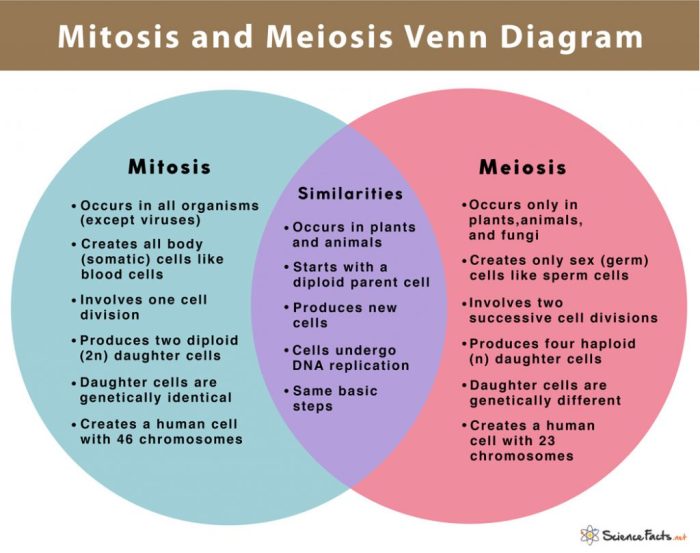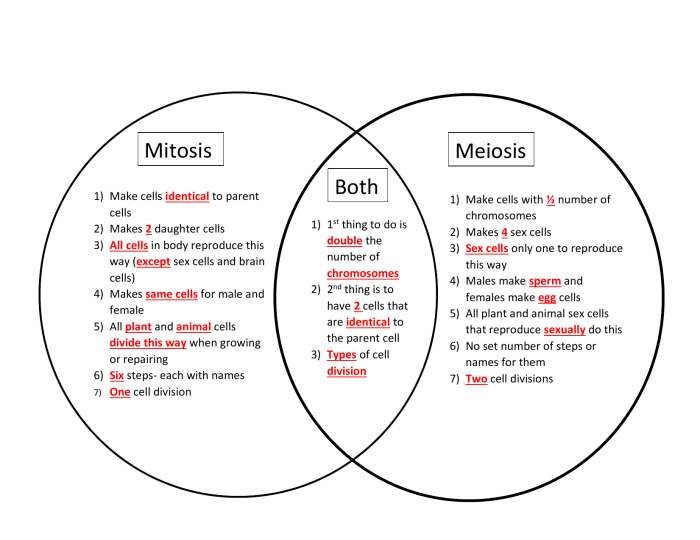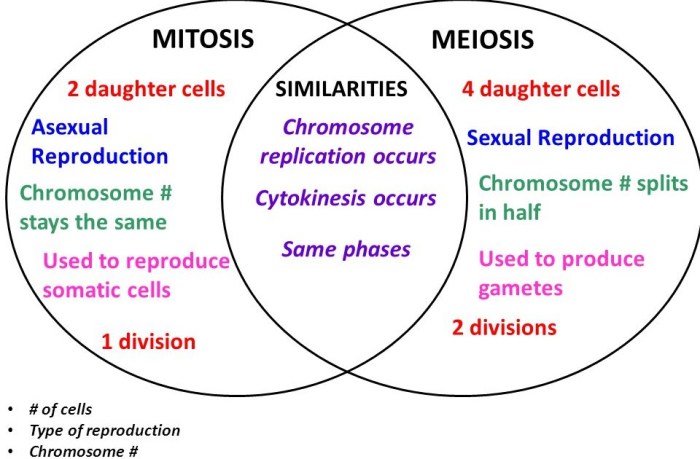Mitosis versus meiosis venn diagram: Embark on an intriguing journey to decipher the fundamental distinctions between these two pivotal cellular processes. Delve into a world of genetic intricacies and discover the profound implications they hold for life as we know it.
Mitosis and meiosis, two sides of the same cellular coin, share common ground yet diverge in remarkable ways. This venn diagram unravels the intricate tapestry of their similarities and differences, shedding light on their unique roles in the symphony of life.
Mitosis vs. Meiosis

Mitosis and meiosis are two distinct cell division processes that occur in eukaryotic cells. Mitosis is responsible for the growth and repair of tissues, while meiosis is responsible for the production of gametes (sex cells).
Key Differences
The key differences between mitosis and meiosis are summarized in the following table:
| Characteristic | Mitosis | Meiosis |
|---|---|---|
| Number of daughter cells | 2 | 4 |
| Chromosome number | Diploid (2n) | Haploid (n) |
| Purpose | Growth and repair | Production of gametes |
Stages of Mitosis

Mitosis is a type of cell division that results in two daughter cells that are genetically identical to the parent cell. It is a continuous process, but for the sake of study, it can be divided into four distinct stages: prophase, metaphase, anaphase, and telophase.
The stages of mitosis are as follows:
Prophase
- The chromosomes become visible as long, thin threads.
- The nuclear envelope breaks down.
- The spindle fibers form and attach to the chromosomes.
Metaphase, Mitosis versus meiosis venn diagram
- The chromosomes line up in the center of the cell.
- The spindle fibers are attached to the chromosomes at their centromeres.
Anaphase
- The spindle fibers shorten, pulling the chromosomes apart.
- The chromosomes move to opposite ends of the cell.
Telophase
- The chromosomes reach the opposite ends of the cell.
- The spindle fibers disappear.
- The nuclear envelope reforms around each set of chromosomes.
- The cell membrane pinches in the middle, dividing the cell into two daughter cells.
Stages of Meiosis

Meiosis is a specialized form of cell division that produces gametes, or sex cells, such as eggs and sperm. Unlike mitosis, which produces two genetically identical daughter cells, meiosis produces four genetically distinct daughter cells. Meiosis occurs in two stages: meiosis I and meiosis II.
Meiosis I
Meiosis I begins with a diploid cell, which contains two copies of each chromosome. During prophase I, the chromosomes condense and become visible. Homologous chromosomes, which are pairs of chromosomes with the same genetic information, pair up and undergo crossing over.
Crossing over is a process in which homologous chromosomes exchange genetic material, resulting in new combinations of alleles. After crossing over, the chromosomes align at the equator of the cell during metaphase I. In anaphase I, the homologous chromosomes separate and move to opposite poles of the cell.
Telophase I follows, during which the chromosomes decondense and the cell divides into two haploid cells, each containing one copy of each chromosome.
Meiosis II
Meiosis II begins with the two haploid cells produced by meiosis I. During prophase II, the chromosomes condense again and the spindle fibers form. In metaphase II, the chromosomes align at the equator of the cell. In anaphase II, the sister chromatids of each chromosome separate and move to opposite poles of the cell.
Telophase II follows, during which the chromosomes decondense and the cell divides into four haploid cells. These four cells are genetically distinct from each other and from the parent cell.
Significance of Crossing Over and Genetic Recombination
Crossing over and genetic recombination during meiosis are essential for genetic diversity. By exchanging genetic material between homologous chromosomes, crossing over creates new combinations of alleles. This increases the genetic variation within a population, which is important for adaptation and survival.
Genetic recombination also helps to ensure that each gamete receives a unique combination of chromosomes, which increases the chances of producing offspring with a favorable combination of traits.
Regulation and Control of Mitosis and Meiosis: Mitosis Versus Meiosis Venn Diagram

Mitosis and meiosis are tightly regulated processes essential for cell division and reproduction. Several mechanisms ensure their accurate execution, including checkpoints and cell cycle proteins.
Checkpoints
Checkpoints are critical control points in the cell cycle that monitor cell readiness before proceeding to the next phase. They ensure that essential processes, such as DNA replication and chromosome segregation, are completed correctly.
- G1 Checkpoint:Checks for nutrient availability, growth factors, and DNA damage.
- G2 Checkpoint:Ensures DNA replication is complete and DNA damage is repaired.
- M Checkpoint:Confirms proper chromosome attachment to the spindle before anaphase.
Cell Cycle Proteins
Cell cycle proteins, such as cyclins and cyclin-dependent kinases (CDKs), play crucial roles in regulating mitosis and meiosis. Cyclins bind to CDKs, activating them and driving cell cycle progression.
- Cyclins:Accumulate and degrade in a specific order during the cell cycle, controlling the activity of CDKs.
- Cyclin-Dependent Kinases (CDKs):Kinases that phosphorylate target proteins, regulating their activity and promoting cell cycle progression.
Applications of Mitosis and Meiosis

Mitosis and meiosis are essential processes for the growth, development, and reproduction of organisms. Mitosis is responsible for cell division, while meiosis is responsible for the production of gametes (eggs and sperm). Both processes have important applications in biotechnology and medicine.
Applications of Mitosis
Mitosis is used in a variety of biotechnology applications, including:
- Cloning: Mitosis is used to create clones of plants and animals. This is done by taking a cell from the organism to be cloned and growing it in a culture medium. The resulting cells are genetically identical to the original cell.
- Stem cell research: Mitosis is used to grow stem cells in culture. Stem cells are unspecialized cells that can develop into any type of cell in the body. This makes them a valuable resource for research and regenerative medicine.
Applications of Meiosis
Meiosis is used in a variety of genetic engineering and reproductive technologies, including:
- Genetic engineering: Meiosis is used to create genetically modified organisms (GMOs). This is done by introducing new genes into the gametes of an organism. The resulting offspring will inherit the new genes.
- Reproductive technologies: Meiosis is used in a variety of reproductive technologies, including in vitro fertilization (IVF) and preimplantation genetic diagnosis (PGD). IVF is a process in which eggs are fertilized in a laboratory dish. PGD is a process in which embryos are tested for genetic disorders before they are implanted in the uterus.
FAQ Insights
What is the primary distinction between mitosis and meiosis?
Mitosis produces two genetically identical daughter cells, while meiosis produces four genetically diverse daughter cells.
How many rounds of division occur in mitosis and meiosis?
Mitosis occurs in one round of division, while meiosis occurs in two rounds of division (meiosis I and meiosis II).
What is the significance of crossing over in meiosis?
Crossing over shuffles genetic material between homologous chromosomes, increasing genetic diversity in offspring.
